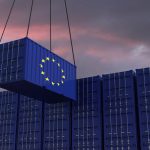As details on Sunday’s EU-US trade deal emerge, Europeans are split in two camps. Some believe the 15 percent tariff ceiling on most products is the best the EU could get from President Donald Trump’s administration. But others criticise the European Union for its timid response. By that logic, forceful retaliation and a tougher negotiating style would have compelled the US to move, but the European Commission let that opportunity pass and signed a suboptimal deal. French Prime Minister Francois Bayrou spoke of a “dark day” and an act of “submission”.
This is almost comical from the French government. It is the second-largest member state, it was certainly closely involved in negotiations – and it holds considerable influence in Ursula von der Leyen’s Commission.
But regardless of who is to blame and what other motives drove the EU to accept the deal, the agreed terms are a far cry from what the EU originally wanted.
The agreement entrenches arbitrary horizontal tariffs, it breaks WTO rules through bilateral sectoral tariff concessions and it reinforces technological dependence. Yet the narrative of a single “dark day” does not capture the problem. This EU-US deal was not a freak accident in an otherwise well-ordered EU trade policy environment. Instead, it exposes four structural weaknesses in the EU’s long-standing approach to trade. If the EU fails to address them, the next round of negotiations will likely be no different.
Member states will blame the Commission rather than own up
No matter how good or bad the EU-US deal is, the Commission is not the only – and not even the first one – to blame or credit. It does not take decisions of this importance without involving national governments and it certainly did not call the shots alone this time.
Although trade is an exclusive EU competence, member states play an important role. And the higher the stakes, the more important this role becomes. The Commission is empowered and constrained by the political mandate it receives from the member states behind the scenes.
Member states give a lot of guidance while remaining in the shadow of plausible deniability. Throughout the negotiations with the US, signals were mixed at best. Some states called for strong retaliation; others were more reluctant – and many preferred to kick the can down the road. Member states cannot have it both ways. Nor can they expect the Commission to take a position they are ultimately unwilling to back when push comes to shove.
This situation creates an important asymmetry. A divided EU can still accept a bad deal that is better than no deal. But only a united EU with a clearly mandated Commission can engage in a sustained trade war and weather the short-term domestic costs. With so many governments refusing to take responsibility for the deal, the EU has not strengthened its hand for the future.
Strategic vulnerabilities constrain the EU’s ability to act
Those who blame the Commission for not leveraging the EU’s trade power more forcefully tend to forget the other constraints. Trade is not the only issue at stake in transatlantic relations, so any assessment of the deal that ignores the broader geopolitical context falls short.
There are limits to how much confrontation the EU can afford with the US. After all this is the country it depends on for the continent’s security, including for sustaining Ukraine’s self-defence. The US administration has shown it is more than willing to leverage this dependence.
Beyond immediate security concerns, there are multiple choke points controlled by the US. These include some critical technologies, as well as digital and financial infrastructure. Many of these dependencies can be reduced over time, but in the short to medium term, they cannot be ignored. Concurrently, this is a cautionary tale for the EU regarding how much it could play hardball with China. As long as it continues to be completely dependent on China, such as on rare earths, the bloc is vulnerable to coercion.
Member states are unwilling to pay for a forceful response
Even without critical dependencies, the EU is an easy target for coercion. The power of fragmented national interests creates myriad pressure points. Even relatively small industries – if they are concentrated and well-organised – can sway the EU’s stance.
For example, early in the negotiations, France and Italy insisted that US bourbon was removed from a EU retaliation list. This is because of US threats to imports from the EU of spirits, which only made it back onto the list in mid-July. France was particularly worried about its Cognac production, an industry whose annual turnover amounts to less than 0.02 percent of EU GDP. Germany’s automotive industry was a central factor behind Berlin’s push for a quick deal with the US, ready to throw other interests under the bus. Additionally, big German brands engaged in their own parallel trade diplomacy.
The case of French Cognac and German cars speaks to a larger point. Member state governments cling to narrowly defined national interests – and they do so even if they can afford to contribute more to a European response, as is the case for Germany. If the EU finds no way to distribute the costs of tariffs and retaliation, the unity needed for such measures will be difficult to achieve.
The impact of US tariffs varies greatly between member states. For example, exports to the US amount to 3.4 percent of Slovakia’s GDP, but only 0.16 percent for Cyprus. This means the fiscal and political costs of a trade confrontation are very unevenly distributed.
At the same time, the fiscal and political space to act is distributed unevenly. Each EU member should recognise its intrinsic interest in the bloc’s ability to act, even if it comes at a price. However, there are limits to what is politically feasible for each member state. The EU can and should not offer full compensation for the impact of the tariffs, but it cannot afford to ignore how costs are distributed either.
The EU used to look dogmatic on trade, now it looks hypocritical
What is true for the member states within the EU is true for the EU in the global context. It is unwilling to walk the talk and pay the price for its own principles.
Since its inception, the EU has seen itself as a champion of multilateral trade, even throughout the ongoing WTO paralysis. This was despite the WTO’s obvious inability to deal with contentious issues that harm EU core interests, such as Chinese and American industrial subsidies and China’s overcapacities. With its legalistic interpretation of trade rules, the EU gained a reputation of inflexibility among its trading partners, especially in the Global South.
This is in stark contrast with Sunday’s agreement. The zero-for-zero offer on goods such as aircraft and some agricultural products breach WTO rules, which do not allow narrow sectoral agreements.
The underlying issue is that the EU has not found a way of reconciling its principled trade dogmatism with its real-world interests.
Predictably, this results in double standards. And this will continue as long as the EU either refuses to abandon its dogmatism or decides to take one for the team. This would involve refusing offers that breach WTO rules, even if this incurs considerable short-term costs for the greater good of having a multilateral trading system. But the bloc cannot have its multilateral cake and eat it, too.
Getting ready for the long haul
Given the Trump administration’s erratic nature, the deal struck on 27 July is unlikely to be the final word on EU-US trade. It is not a legally enforceable formal agreement. Instead, it’s a kind of truce that can end at any time if incentives are no longer there. This includes credible threats of retaliation if the terms are violated.
The EU – including national governments – should use the time this deal buys to get ready for the long haul. If they do not recognise the structural failings behind this particular failure, the next negotiated outcome will be no different. More results like this are likely to happen unless the EU shifts gears.
About the author
Etienne Höra is Project Manager at the Europe’s Future program at Bertelsmann Stiftung.
Read more about trade and tariffs
Red Lines and Retaliation: The EU’s Response to Trump’s Tariffs
How to Survive a Trade War: A Case for EU Burden-sharing
Draghi Report and EV Tariffs: Why a Stop Now Would Send the Wrong Signal






Kommentar schreiben